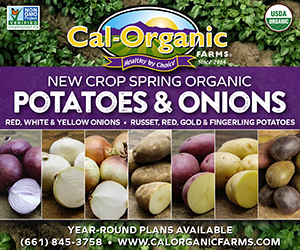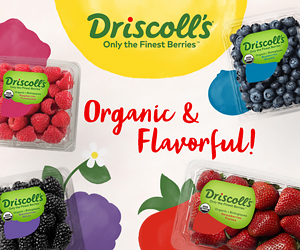Mim Michelove is the co-founder and director of Healthy Day, an organization that is responsible for creating two certified-organic, school-district-owned farms in Encinitas, CA—the first of their kind in the country. She is currently at work in National City, helping the local school district create farm-to-school garden programs that give all 6,000 elementary students access to a healthy, locally sourced school lunch. Mim joined OPN for a conversation about her work.
 Mim Michelove, Co-Founder of Healthy Day
Mim Michelove, Co-Founder of Healthy Day
How did you get started in your work with organic produce and farming in schools?
I don’t necessarily have a clear answer because it happened from so many different angles over a good period of time, but becoming a mother made me think far more deeply and get more passionate about the connection between environmentalism and healthy food and getting kids to be healthier in a holistic way.
Which of those did you focus on first - environmentalism or healthy food?
It was kind of both. They were parallel tracks. As a parent volunteer at my son’s school, I started an environmental program and a garden program, as well as all kinds of initiatives like waste-free lunch and walk-to-school days. And I also noticed that the school lunch wasn’t as healthy as it could’ve been. And so it all just kind of came together at the same time, centered around the school garden.
The cool thing in Encinitas, what really made it all work, was that the superintendent started a district-wide Green Team. Attending the Green Team meetings helped me grow into understanding the district’s systems. And it turns out that I’m really into systems change! If you don’t change the system, nothing’s going to last.
 Healthy Day has created two certified-organic, school-district-owned farms in Encinitas, CA
Healthy Day has created two certified-organic, school-district-owned farms in Encinitas, CA
How did you go about incorporating the produce from the school gardens into the lunch program?
Getting it connected to a federal school lunch program was really, really hard back like 12 years ago now. And so with my first school garden, we were not really that successful. I learned a lot of lessons, and I got people talking about it and thinking about it, but I didn’t actually get garden produce into more than one school.
By the time I started my second school garden, I had a pretty good track record of getting the entire school involved in garden-based education, and winning grants. And I did some experiments like working with the food service director to make kale chips from garden-grown produce. But he was not readily open to accepting produce from the school garden on a regular basis and would only allow small portions to be offered to the side of the main serving area, not on the salad bar, so it just took a very long time to integrate fresh foods into school lunch.
 Mim has inspired students and teachers to get involved in garden-based education
Mim has inspired students and teachers to get involved in garden-based education
What was the turning point?
By the time the food service director found an opportunity elsewhere, the school district had a good idea of how to hire someone to support this new programming. This helped shift a lot of things.
The new food service director and I were in close communication about what was growing and when it would be harvested. Early on, I had kids growing and harvesting things like sweet potatoes and butternut squash. And the food service director said, “Let’s turn that into soup and serve it with a grilled cheese sandwich.” We would menu develop together, and she always made it happen! We were able to let the kids know that their harvests would be served at lunch, and they’d get so excited to eat what they grew! That’s really how we built the farm-to-school connection.
By this time, I was into my third garden, which actually turned into a farm. That was the first educational farm, on a one-acre unused lot at Ocean Knoll Elementary School. It was a proof of concept that really helped us figure out how to consistently provide and transport food from the school gardens and farms to the entire school district. I used to grow, harvest, weigh, rinse, and transport crops myself until we figured out how to incorporate all of these tasks into the system and hire professional farmers. It took quite a while. We also worked with our local Department of Environmental Health to make sure we were compliant with all regulations.

Mim worked closely with kids and the school district, helping them grow items such as sweet potatoes and butternut squash
How did you form your nonprofit, Healthy Day, and what role did it play in starting the two farms, Ocean Knoll Farm and Farm Lab?
I’m a co-founder of Healthy Day Partners. Another mom from another school who also sat on the district Green Team said she wanted to start a nonprofit and asked me if I was interested. I said, “Yes!” We fit perfectly. She kind of leaned more on the environmental side of things, and I got really into the school gardens and then created the one-acre Ocean Knoll Farm, which eventually led me to creating another farm on 10 acres of district-owned land, Farm Lab.
Our nonprofit Healthy Day is how we were able to start Ocean Knoll Farm, honestly. The school district didn’t have the funds; they didn’t have the means; I’m not even sure they had the desire; so they asked Healthy Day do it. So we raised all the money, and we worked with the district to do the tractor work and ditch digging, but we paid for all the materials and all the irrigation. We also raised money to build a stage and lots of spaces to use as outdoor classrooms.
 Local grocery store Jimbo's helped to fund Ocean Knoll Farm
Local grocery store Jimbo's helped to fund Ocean Knoll Farm
Who were the main funders?
The local, family-owned grocery store Jimbo’s. They got involved early on and have supported me all the way through becoming certified organic—and beyond. And then there have been lots and lots of churches, and Rotary Clubs, and all kinds of organizations that have volunteered and donated and helped me build both farms—because the district had limited funding for creating Farm Lab, too. I also received substantial funding from the County of San Diego, SDG&E (our local utility company), and the Whole Kids Foundation, as well as some corporate sponsors.
Why did you decide to get both farms certified organic?
We used organic growing methods for years, and my goal was to become certified organic for a couple of reasons: One was to sell in Jimbo’s. We wanted to be able to sell excess produce for revenue and let the community get a taste of what was happening in our schools. In order to sell at Jimbo’s, we had to be certified organic. Also, I knew that I wanted the healthiest food for my own child, and if I wanted that for him, I should want that for everybody. Organic certification is a pretty rigorous process, and it makes it absolutely transparent to the public that you are growing your food in the healthiest way possible.
 Mim and Healthy Day have recently built 10 school gardens in the National School District
Mim and Healthy Day have recently built 10 school gardens in the National School District
Can you tell us a bit about your current work in National City?
I got to a point in Encinitas where I was like this is really happening. The systems are set up. This is working. They’re in very good shape at the Farm Lab campus, and in the farm-to-school program. What I really want to do is go to economically disadvantaged communities where similar programs could have real impact.
So, in 2018, I met with the San Diego County Health and Human Services Agency, and we identified the three top school districts where we thought we could have the most impact. We soon learned that National City had the highest obesity rate in San Diego County, and so we knew we wanted to be there! Studies have shown us over and over again that if kids learn early on to eat healthfully, they’re not going to put on that weight that’s going to drive them toward obesity and chronic disease.
I feel like the children in National City are my children too. They are all of our children. Unfortunately, they do not have equal access to healthy food. And to me that’s just unacceptable! All I know is that I have this expertise, and I want to bring it where it’s needed. I’m not riding in on a white horse. I’m just trying to bring my knowledge to a place where I think it could be useful. Luckily, I found some amazing partners at Olivewood Gardens and Learning Center. In our first pilot, Olivewood was able to grow enough lettuce to serve at all 10 elementary schools three days a week on their salad bars. It was awesome! And Healthy Day just finished building the last of 10 school gardens, so now all 6,000 elementary school kids in National School District have equal access to school garden programs. I’m so proud of that.






